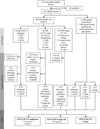MRI-guided breast biopsy: outcomes and effect on patient management
- PMID: 25499596
- PMCID: PMC4361320
- DOI: 10.1016/j.clbc.2014.11.003
MRI-guided breast biopsy: outcomes and effect on patient management
Abstract
Introduction: The purpose of this study was to correlate the pathology results of MRI-guided breast biopsies at our institution with MRI findings and patient clinical history characteristics. The effect of MRI-guided breast biopsies on surgical management in patients with a new diagnosis of breast cancer was also assessed.
Patients and methods: In this Health Insurance Portability and Accountability Act-compliant study we retrospectively reviewed all MRI-guided breast biopsies performed from March 2006 to May 2012. Clinical history, MRI features, and pathology outcomes were reviewed. In patients who underwent breast MRI to evaluate extent of disease, any change in surgical management resulting from the MRI-guided biopsy was recorded. Statistical analysis included binary logistic regression and independent Student t test.
Results: Two-hundred fifteen lesions in 168 patients were included, of which 23 (10.7%) were malignant, 43 (20%) were high-risk, and 149 (69.3%) were benign. No clinical characteristic was associated with malignancy in our cohort. MRI features associated with malignancy were: larger size (mean 2.6 cm vs. 1.3 cm; P = .046), washout kinetics (18% malignancy rate; P = .02), and marked background parenchymal enhancement (40% malignancy rate; P < .001-.03). Nineteen (28%) of the 67 patients with a new diagnosis of breast cancer who underwent MRI-guided breast biopsy had a change in surgical management based on the biopsy result.
Conclusion: Malignancy rate was associated with lesion size, washout kinetics, and marked background enhancement of the breast parenchyma but was not associated with any clinical history characteristics. Preoperative MRI-guided breast biopsies changed surgical management in 28% of women with a new diagnosis of breast cancer.
Keywords: Breast MRI; Core biopsy; MRI-guided biopsy; Pre-operative breast MRI.
Copyright © 2015 Elsevier Inc. All rights reserved.
Conflict of interest statement
Disclosures: Authors KJM and IRK had a financial relationship with commercial organizations that may have direct or indirect interest in the content: author KJM had a research grant from Siemens (Munich, Germany).
Figures





Similar articles
-
Apocrine Metaplasia Found at MR Biopsy: Is There Something to be Learned?Breast J. 2017 Jul;23(4):429-435. doi: 10.1111/tbj.12755. Epub 2017 Jan 12. Breast J. 2017. PMID: 28079289
-
Magnetic resonance imaging-guided core needle breast biopsies resulting in high-risk histopathologic findings: upstage frequency and lesion characteristics.Clin Breast Cancer. 2015 Jun;15(3):234-9. doi: 10.1016/j.clbc.2014.12.005. Epub 2014 Dec 24. Clin Breast Cancer. 2015. PMID: 25579460
-
Cancelation of MRI guided breast biopsies for suspicious breast lesions identified at 3.0 T MRI: reasons, rates, and outcomes.Acad Radiol. 2013 May;20(5):569-75. doi: 10.1016/j.acra.2013.01.005. Epub 2013 Mar 6. Acad Radiol. 2013. PMID: 23473719
-
Breast Biopsies Under Magnetic Resonance Imaging Guidance: Challenges of an Essential but Imperfect Technique.Curr Probl Diagn Radiol. 2016 May-Jun;45(3):193-204. doi: 10.1067/j.cpradiol.2015.07.002. Epub 2015 Jul 10. Curr Probl Diagn Radiol. 2016. PMID: 26272705 Review.
-
MRI-guided breast interventions.J Magn Reson Imaging. 2017 Sep;46(3):631-645. doi: 10.1002/jmri.25738. Epub 2017 May 4. J Magn Reson Imaging. 2017. PMID: 28470744 Review.
Cited by
-
Performance Benchmark Metrics and Clinicopathologic Outcomes of MRI-Guided Breast Biopsies: A Systematic Review and Meta-Analysis.Eur J Breast Health. 2023 Jan 1;19(1):1-27. doi: 10.4274/ejbh.galenos.2022.2022-12-1. eCollection 2023 Jan. Eur J Breast Health. 2023. PMID: 36605469 Free PMC article.
-
Evaluation of background parenchymal enhancement on breast MRI: a systematic review.Br J Radiol. 2017 Feb;90(1070):20160542. doi: 10.1259/bjr.20160542. Epub 2016 Dec 7. Br J Radiol. 2017. PMID: 27925480 Free PMC article.
-
False-positive incidental lesions detected on contrast-enhanced breast MRI: clinical and imaging features.Breast Cancer Res Treat. 2023 Apr;198(2):321-334. doi: 10.1007/s10549-023-06861-y. Epub 2023 Feb 6. Breast Cancer Res Treat. 2023. PMID: 36740611
-
Recent Progress for the Techniques of MRI-Guided Breast Interventions and their applications on Surgical Strategy.J Cancer. 2020 May 20;11(16):4671-4682. doi: 10.7150/jca.46329. eCollection 2020. J Cancer. 2020. PMID: 32626513 Free PMC article. Review.
-
Application value of MRI-guided wire localization to the non-palpable breast lesions only shown in Breast MRI.Front Oncol. 2024 May 24;14:1325362. doi: 10.3389/fonc.2024.1325362. eCollection 2024. Front Oncol. 2024. PMID: 38854734 Free PMC article.
References
-
- Peters NH, Borel Rinkes IH, Zuithoff NP, et al. Meta-analysis of MR imaging in the diagnosis of breast lesions. Radiology. 2008;246(1):116–124. - PubMed
-
- Schnall MD, Blume J, Bluemke DA, et al. Diagnostic architectural and dynamic features at breast MR imaging: multicenter study. Radiology. 2006;238:42–533. - PubMed
-
- Mahoney MC. Initial clinical experience with a new MRI vacuum-assisted breast biopsy device. J Magn Reson Imaging. 2008;28:900–9054. - PubMed
-
- Orel SG, Rosen M, Mies C, Schnall MD. MR imaging-guided 9-gauge vacuum-assisted core-needle breast biopsy: initial experience. Radiology. 2006;238:54–615. - PubMed
-
- Lehman CD, Deperi ER, Peacock S, McDonough MD, Demartini WB, Shook J. Clinical experience with MRI-guided vacuum-assisted breast biopsy. AJR. 2005;184:1782–1787. - PubMed
Publication types
MeSH terms
Grants and funding
LinkOut - more resources
Full Text Sources
Other Literature Sources
Medical

